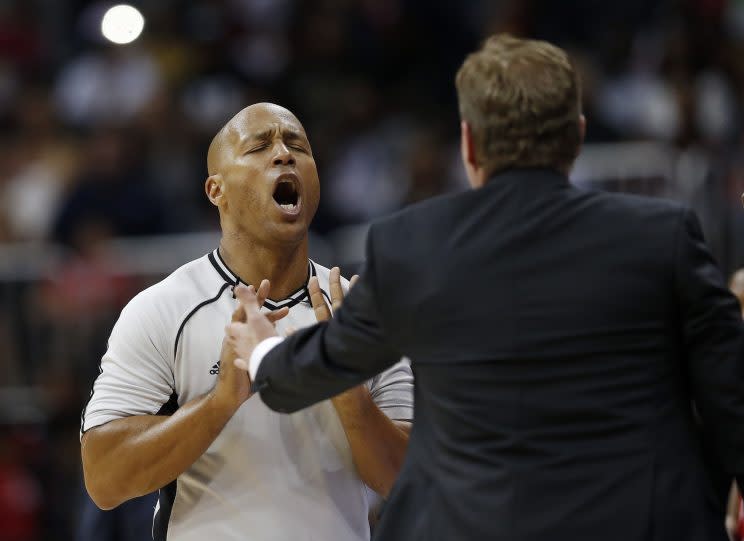NBA exec: Last-two-minute ref reports will 'probably' cover full game soon enough

Giannis Antetkounmpo handed the Milwaukee Bucks a win on Wednesday with a star-making buzzer-beater against the New York Knicks at Madison Square Garden. It was a thrilling moment, the sort of play that shows the sports world what a bright young talent can do while simultaneously building his reputation in the eyes of many. Antetokounmpo is the runaway favorite for Most Improved Player and soon to make his first All-Star team, and this play will be one of those that people remember when they look back on his season this spring.
[Join a Yahoo Daily Fantasy Basketball contest now | Free NBA Yahoo Cup entry]
According to the NBA, it shouldn’t have counted. The league’s daily “Last Two Minutes Report” on missed calls at the ends of games said that Antetokounmpo dribbled with his back to the basket for 5.6 seconds, a violation that should have resulted in a turnover. The report noted several other calls that should have gone in the Bucks’ favor, but the big news was that the most exciting play of the night should have been ruled unacceptable.
If the man in charge of these reports is to be believed, then the reports will soon extend from the last two minutes of every game to the full 48. Zach Lowe of ESPN.com spoke to Kiki Vandeweghe, the NBA’s vice president of basketball operations, for a column on the increase in scoring this season. Tucked into that piece is a note on the future of the L2M reports:
Team officials privately worry how deadly offenses could become if the league returns to the zero-tolerance policy on handchecking that helped boost pre-lockout scoring numbers. It’s hard to prove, but most coaches and front-office executives agree defenses get away with a little more bump-and-grind than in the mid-2000s — when the NBA was obsessed with creating a more viewer-friendly game. The league has heard the concerns, and is monitoring the handcheck stuff. “That area is tough — the freedom of movement, especially away from the ball,” Vandeweghe said. “It’s tough for referees to watch everything. But I think we’ve found a good balance.”
(As an aside, Vandeweghe confirmed the controversial last-two-minute reports aren’t going anywhere. In fact, he said the NBA would “probably” start releasing full game reports at some point.)
As noted by USA Today’s Jeff Zillgitt, the league already produces the longer reports for teams:
By the way, teams already get full-game officiating reports for the games in which they play. Just not made public. https://t.co/GX3dypMo3E
— Jeff Zillgitt (@JeffZillgitt) January 5, 2017
In other words, publishing the full referee report would not require any extra work and would serve public relations purposes more than anything else. Whether that step is more trouble than it’s worth is an open question.
We have written on these reports several times, to the point where it’s not worth detailing the different opinions on them in too much depth. The referees hate them (which shouldn’t surprise anyone). Players rightfully think they represent a double standard relative to the league’s policing of their own criticism of referees. Fans love or hate them depending on what it means for the correct result of close games involving their teams, and epistemology-minded freaks like me wonder what it means to determine several calls wrong on the same play when each relates to the others in the moment. The only people who really seem to appreciate the reports are those who see transparency and gestures toward the truth as good developments in and of themselves, which is a philosophical argument to have another time.
[Follow Ball Don’t Lie on social media: Twitter | Instagram | Facebook | Tumblr]
However, those who don’t like the reports may paradoxically prefer having them cover the entire game. The L2M report for Wednesday’s Bucks-Knicks game assesses 18 incidents, a rather high number given the excitement of the finish but not an absurd total given everything officials have to assess when 10 high-level athletes compete at the same time. Of those 18 notices, enough calls or no-calls benefited the Knicks that it’s nearly impossible to claim the referees were biased toward one team.
Now imagine this report covered 24 times the length of game time and at least 150 on-court incidents. The totality of the assessments would render each individual call so insignificant as to be meaningless. No one could argue referee bias with any degree of intellectual honesty, and those who did would come across as even bigger conspiracy theorists than they already do. In a way, extending the referee reports to the full game would make reasoned consideration of these plays a matter of study for only the truest diehards.
Or maybe transparency and the pursuit of truth have always been red herrings, and we only obsess over officiating because it’s a convenient way to explain a complicated and ultimately arbitrary form of competition that can’t always determine a winner with perfect fairness. You make the call!
– – – – – – –
Eric Freeman is a writer for Ball Don’t Lie on Yahoo Sports. Have a tip? Email him at efreeman_ysports@yahoo.com or follow him on Twitter!



